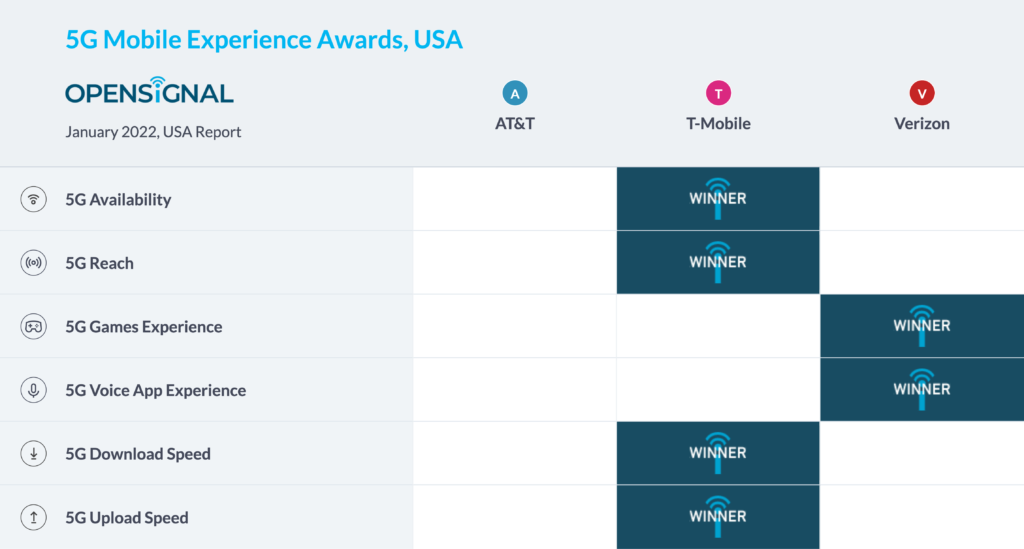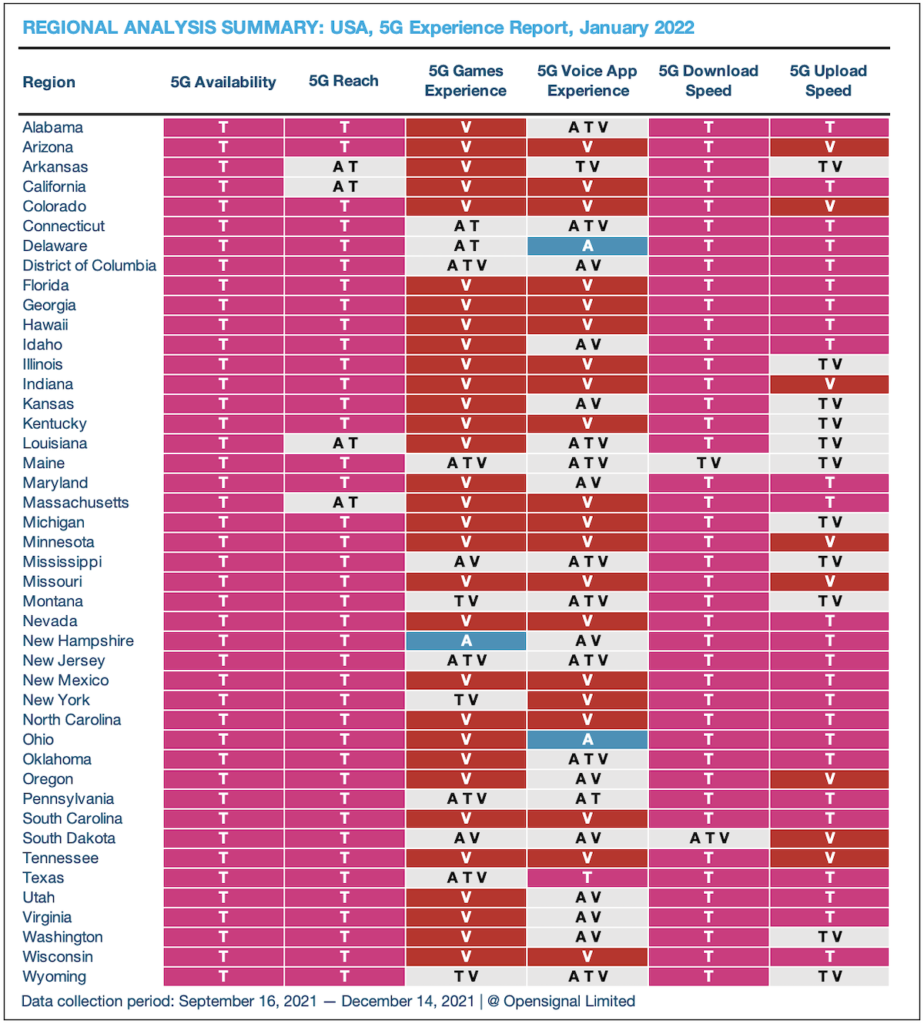
OpenSignal is known for its mobile analytics. Each year they release a few reports about the major cellular carriers’ networks. They take results gathered from millions of devices, which result in billions of measurements. The latest data gathered, which was collected between September and December of last year, shows T-Mobile is on top once again.
Analysis was done in 43 states, as well as the capital of Washington, D.C., for each of the carriers strictly on their 5G network experience. The report covered: Availability, Reach, Games Experience, Voice App Experience, Download Speed and Upload Speed.
T-Mobile was not the only winner though. Verizon also picked up the categories of Games Experience and Voice App Experience. Sadly, for AT&T, they didn’t win any categories, but still presented good results in comparison to its competitors. It’s no wonder given that T-Mobile has not had to deal with the issues surrounding C-Band that AT&T and Verizon have. This service was originally delayed, then limited to certain locations – all because of possible interference with aircraft tools that also work around the C-Band spectrum.
While Verizon has the best user experience, T-Mobile dominates the speed categories. In fact, they’ve been at the top of the Download Speed category for six times in a row and Upload Speeds for the fifth time in a row.
T-Mobile also won the Availability and Reach categories. It’s clear their lead on getting mid-band service out to 200 million users was a success. This is what they have dubbed their “Ultra Capacity 5G” service. It relies on the 2.5 Ghz band, so it is unaffected by the FAA concerns that have affected the C-Band.
Now let’s take a closer look at how all the carriers fared in each category, at the National Analysis level.
Note that each of the OpenSignal charts listed below have brackets at the end of their respective graphs. These brackets represent confidence intervals. Per OpenSignal, “For every metric we calculate statistical confidence intervals indicated on our graphs. When confidence intervals overlap, our measured results are too close to declare a winner. In those cases, we show a statistical draw. For this reason, some metrics have multiple operator winners. In our bar graphs we represent confidence intervals as boundaries on either sides of graph bars. In our supporting-metric charts we show confidence intervals as +/- numerical values.”
- 5G Availability
“Opensignal’s 5G Availability compares the amount of time 5G users spent with an active 5G connection — the higher the percentage, the more time that users on a network were actually connected to 5G.”

- 5G Reach
“5G Reach represents the proportion of locations where 5G users have connected to 5G out of all the locations those users have visited, on a scale of 0-10. This measure complements our existing 5G Availability metric, which represents the proportion of time 5G users spent connected to 5G.”

- 5G Games Experience
“Opensignal’s 5G Games Experience measures how mobile users experience real-time multiplayer mobile gaming on an operator’s 5G network. Measured on a scale of 0-100, it analyzes how the multiplayer mobile gaming experience is affected by mobile network conditions including latency, packet loss and jitter.”

- 5G Voice App Experience
“Opensignal’s 5G Voice App Experience measures the quality of experience for over-the-top (OTT) voice services — mobile voice apps such as WhatsApp, Skype, Facebook Messenger etc. — when users are connected to a 5G network.”

- 5G Download Speed
“T-Mobile’s 5G Download Speed continues on its upward trend as our users on the carrier now clock average speeds of 150 Mbps, up from 118.7 Mbps in the previous report. A year ago, using T-Mobile our users saw a 5G Download Speed score of 58.1 Mbps, but it has consistently increased since then due to T-Mobile’s ongoing deployment of 2.5 GHz spectrum. The carrier has been increasing both its population coverage, as well as the amount of spectrum deployed on that band.”

- 5G Upload Speed
“T-Mobile keeps hold of the 5G Upload Speed award with a score of 17.9 Mbps, which is 1.8 Mbps faster than what our users observed in our October report. Verizon places second in 5G Upload Speed with a score of 14.1 Mbps, which represents a 0.3 Mbps decrease from our previous report, while AT&T’s score increased from 9.7 Mbps to 9.9 Mbps.”

Analysis was also done at the regional level, which you’ll see outlined below.



